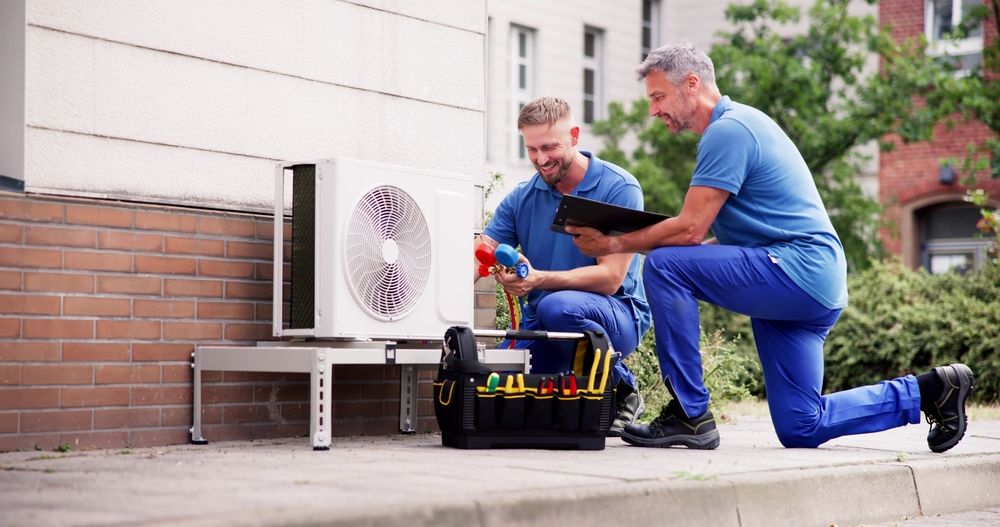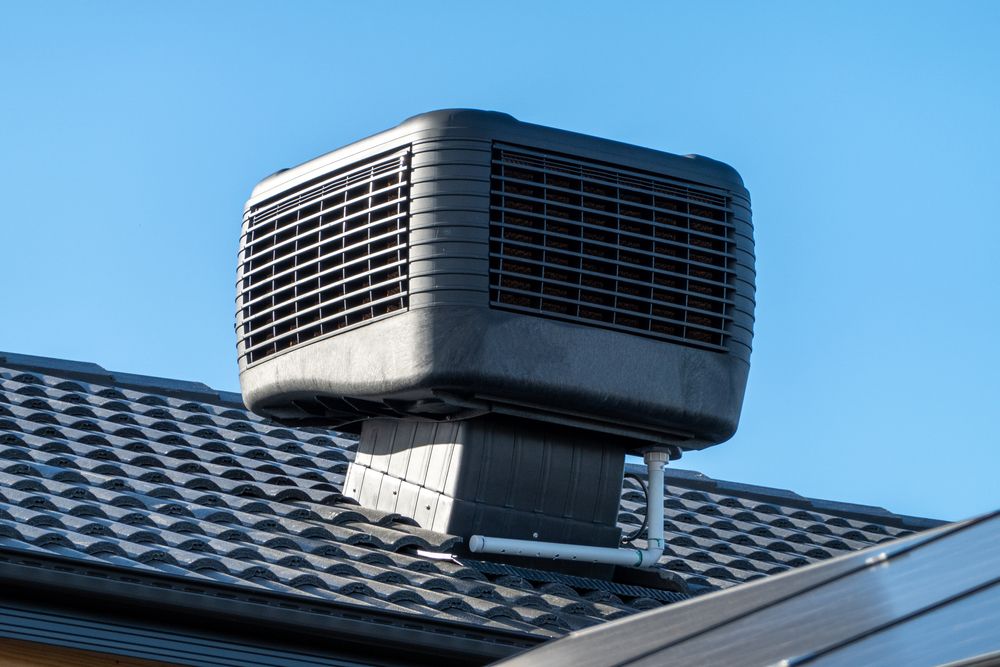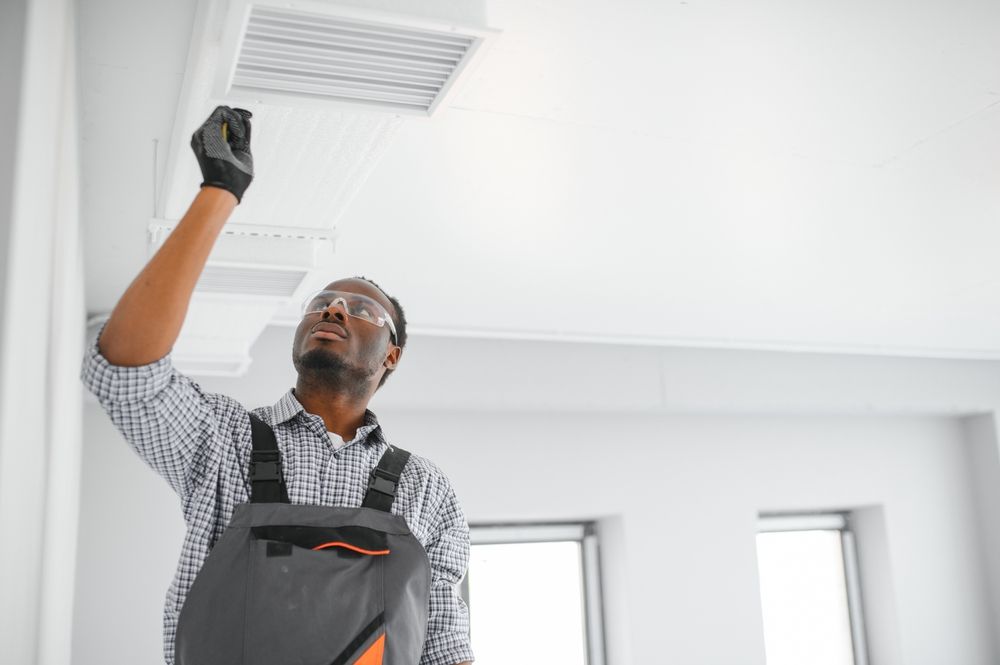
If you’ve ever thought about upgrading an old heating and cooling system, there’s a lot that goes into the decision-making process. Especially when it comes to replacing your evaporative cooling system.
This article will dive into the details of replacing refrigerated cooling with evaporative cooling, the difference between both types of cooling, and whether or not the upgrade is worth it for your residential or commercial property.
Replacing Evaporative with Refrigerated: Is it Possible?
In short, you can, but it is a complex installation. Although evaporative cooling and refrigerated air cons are similar in the use of ducts in the ceiling, evaporative coolers circulate a higher volume of air. Since they use larger diameter outlets and ductwork, refrigerated air conditioning isn’t suited to this layout.
Likewise, ceiling vents used for both have to be located in different positions. If you want to upgrade to refrigerative, an installer must remove the ceiling vents and patch the holes (if any) left behind.
Can you use any existing ductwork?
No. Ducted reverse cycle air conditioning is constructed using smaller ducts in comparison to evaporative options.
Ductwork is configured differently, with the branch ducts matching the zoning system of the ducted reverse cycle instead of an evaporative design. It also has a return air ducting to recirculate the air. You also can’t use your existing outlets.
Can you install new outlets?
Installing new outlets becomes an issue as it is expensive to patch holes and repaint the ceiling after the installation is complete.
Experts sometimes use streamlined diffusers, which direct air to the other side of the room as needed, then it turns back on itself. This can work well, but always speak to an HVAC technician to discuss a way forward.
All in all, a new ducted system needs to be installed to accommodate this changeover.
Likewise, if your home has gas ducted heating, the same ducts can be used for a fully integrated heating and cooling system.
- Your property will be assessed, such as determining the best system and ducting requirements.
- New ductwork is installed so the new system operates at the best capacity and efficiency.
- The system is set up and tested. Airflow and temperature control are verified.
Evaporative Cooling: An Overview

A central cooling system is installed on the roof of your home and connected to a series of vents or ceiling ducts. Warm air from the outside is cooled down when it passes through moist pads, and evaporation occurs. This is the start of the evaporative cooling process.
Cool air is then dispersed throughout the ducts in your home (much like gas ducted heating and cooling or electric reverse cycle). That said, evaporative cooling is different as it works best in summer. The cooled-down air carries moisture, mimicking that feeling of humidity, but it doesn’t make spaces feel sticky.
Benefits of evaporative cooling
- You get a circulation of fresh air, which can filter or trap harmful particles or allergens so they aren’t recirculated from outside.
- It is less expensive and is energy-efficient. Since evaporative cooling only needs electricity to run the water pump and fan, these systems are often cheaper than refrigerated cooling.
- You get something eco-friendly and sustainable. Using a lot less electricity to cool your spaces reduces your carbon footprint.
It is common for people to use portable evaporative coolers for small rooms, but they won’t be as reliable as central ducted systems.
Things to consider before investing in evaporative cooling
- Allergens. During evaporative cooling, your windows should be open for it to work and push out any warm air inside. Although the system traps allergens, it won’t always filter out everything entering through your windows. If you have asthma or sensitivities, it’s something to weigh up.
- Routine maintenance. Filters clog and become less efficient in trapping allergens if you don’t clean the system. Mould and bacteria breed if left for too long.
- Relying on outdoor weather. Since this type of cooling relies on the air outside, you won’t have control over the type of air that enters your property.
- Water. Evaporative systems need water to reach filters for cooling, so you have to be on top of how much water you’re using.
What is Refrigerated Air Conditioning?

Ducted refrigerated air conditioning is just like your kitchen refrigerator. Taking in the hot air outside, refrigerated cooling instead cools with refrigerant gases and returns cooler air into your space.
Basically, the air recirculates inside this system, so your windows must be closed to keep the cool air inside! If you are prone to irritants, nothing external is entering your space.
When compared to evaporative cooling, refrigerated air offers cool temperatures inside, no matter the weather outside.
Some of the reasons you might invest in refrigerated air conditioning
- Suitable for every climate all throughout the year. The good thing about refrigerated cooling is that it does not need outdoor air to cool! It operates without it.
- Temperature is well controlled. Since you’re in charge of the temperature settings, the temperature setting will be cooler.
- Choose from a split system or ducted zoning options. With ducted zoning, you have the freedom to cool or zone off rooms of your home that aren’t being used. A split system, on the other hand, is installed in individual rooms (or just one room, depending on your property size).
Reverse cycle refrigerated systems are an option that can both heat and cool your home.
What else should you think about?
This type of cooling might hike up your electricity bill, so consider how you’d like to structure it in your house.
Since the recirculation of air means that filters need to be cleaned every 3 months, regular maintenance might not be something you’re looking to commit to. Especially if you live in a dusty environment.
If it’s time for general maintenance, fixed repairs and maintenance, scheduled servicing, or commercial maintenance, TTV Heating and Cooling is here to make it easier on you.
Why might evaporative cooling not be for you?
Evaporative cooling processes work with natural air, so the weather outside plays a big role in how effective the system will be. It works best when it’s hot and dry (up to 30 degrees), but it may struggle with cooling output in higher temperatures.
For example, Melbourne summer generally experiences a dry heat and northerly winds, so it isn’t a practical option to open the house up for airflow.
Although cooling rooms this way is a cheaper option to install and run, will it work for your cooling needs? This cools your entire home, but if you spend more time in a single room, zoning options are recommended.
Both systems use electricity, but evaporative cooling uses water (and less electricity) as the cooling process is more reliant on natural air. But this doesn’t work for everyone.
Read: 5 Easy Ways to Lower Your Heating and Cooling Costs!
Why might refrigerated cooling not be a good option?
Refrigerated has two processes: it removes hot air and filters/cools air, but it does have downsides, such as:
- It costs significantly more to run
- Doors and windows need to be closed at all times; this can be frustrating, as it’s easier to lose cool air
- The air isn’t as fresh (it’s more recycled)
- On warm nights, it is more difficult to pull cool air inside your home
- Air isn’t moving, and this is what keeps the air fresh
Refrigerated cooling excels best on humid days, but not with dry heat! For the best of both worlds, run evaporative the majority of the time, and run split systems on really hot/muggy days.
Do you need heating and cooling support in Box Hill, Blackburn, Bulleen, Camberwell, Donvale, Hawthorn, Ivanhoe, Malvern, Surrey Hills, Toorak, South Yarra, Eltham, Kew, or Templestowe? TTV Heating and Cooling offer professional advice, installation, and long-term support.
Some of the industries we serve are:
- Commercial
- Office spaces
- Homes
- Businesses
- Nursing homes
- Offices
- Schools
- Childcare
We’re also a preferred provider to Austin Hospital!
Heating and Cooling for Melbourne Homes: Get in Touch!
Providing great customer service and top-quality products to Australian families since 1962, we continue to grow with the development of energy-efficient heating and cooling solutions and technologies throughout the years.
Expect leading brands such as Mitsubishi Electric and Daikin, 100% product warranty, service and technical support by fully insured and accredited technicians, no subcontractors, and a local showroom.
We are a family-owned and operated business. Get in touch with us today at 03 9852 2335 to schedule your free quote.
